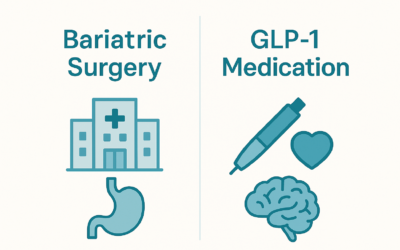Ozempic is everywhere right now. Maybe your coworker mentioned they’ve lost 50 pounds on it. Maybe your doctor brought it up at your last appointment. Maybe it’s all over your social media feed, with influencers calling it a magic shot and celebrities rumored to be on it. Wherever you’ve heard about it, one thing is clear — Ozempic is one of the biggest weight loss and diabetes medications in history.
But as Ozempic’s popularity has exploded, so has the confusion. If you’ve heard anything about it, you’ve probably also heard wildly conflicting claims — that it makes you starve yourself, that it’s just a temporary fix, that you’ll instantly gain all the weight back if you stop taking it, or even that it can cause permanent changes to your metabolism or your brain.
Here’s the truth: most of the scary things you hear about Ozempic aren’t true — at least, not in the way people are making them sound. But there are real things worth knowing about Ozempic before you take it.
So, what exactly is Ozempic? What does it do inside your body? And more importantly, is it something you should consider taking? If you’ve been wondering “what is Ozempic” and why everyone is talking about it, here’s what you need to know.
What is Ozempic, and how does it work?
In a nutshell, Ozempic is a man-made version of a hormone your body already produces: GLP-1 or glucagon-like peptide-1. This hormone plays a huge role in controlling how hungry or full you feel. When you eat, your body naturally releases GLP-1 to help regulate blood sugar and digestion, but it also signals your brain that you’ve had enough food. The problem? GLP-1 doesn’t last very long. It gets broken down quickly, meaning the feeling of fullness fades, and hunger returns sooner than you’d like.
That’s where Ozempic comes in. When asking “‘what is Ozempic'” in terms of how it works, the key lies in its ability to mimic GLP-1 and extend its effects. It mimics GLP-1 — that is, it fools your body into thinking it is GLP-1 — but lasts much longer, keeping those “I’m full” signals going for hours or even days. The result? A dramatically reduced appetite, fewer cravings, and a much easier time eating smaller portions without feeling deprived.
But Ozempic doesn’t just change how much you eat—it can also affect why you eat. Many people who struggle with food cravings or compulsive eating find that their urge to snack constantly or overeat starts to fade. Ozempic doesn’t force you to eat less; it simply makes food less of a mental battle.
At the same time, Ozempic helps stabilize blood sugar levels and make your body more sensitive to insulin — which is a good thing. For people with type 2 diabetes, this is life-changing. But even for people without diabetes, keeping blood sugar steady can help prevent energy crashes and eliminate the cycle of sugar spikes and cravings. No more mid-morning crash and being ravenous before lunch time. No more being hangry before supper.
In short, Ozempic helps you eat less, feel fuller longer, and quiet the relentless “food noise” that makes weight loss so hard. But does that mean it’s the right choice for you? Let’s take a closer look.
What is Ozempic, and who is it actually meant for?
Officially, Ozempic is approved for people with type 2 diabetes. If you’ve ever asked ‘what is Ozempic used for,’ the answer is blood sugar control, but also weight management. It’s meant to help regulate blood sugar and lower A1C levels (a measure of your blood sugar levels over time). But if you’ve heard about it lately, it’s probably because of its off-label use for weight loss. Doctors quickly noticed that patients on Ozempic were losing a significant amount of weight, which led to its rise as one of the most in-demand medications for obesity treatment.
So who benefits most from Ozempic?
- People with type 2 diabetes who need better blood sugar control.
- People with obesity or significant excess weight who have struggled to lose weight with traditional methods.
- People who struggle with portion control, cravings, or food noise — Ozempic doesn’t just help with eating less; it helps reduce the urge to eat as well.
However, Ozempic isn’t for everyone. It’s typically prescribed for people with a BMI of 30 or higher (or 27+ with weight-related health issues like high blood pressure or sleep apnea). If you only want to drop 10 or 15 pounds for aesthetic reasons, most doctors won’t prescribe it — but there are alternative options.
It’s also worth noting that while Ozempic is making headlines for weight loss, the FDA-approved version specifically for obesity is Wegovy — which contains the same active ingredient (semaglutide) but at a higher dose. If your insurance doesn’t cover Ozempic for weight loss, Wegovy may be an option.
So, is Ozempic right for you? That depends on your weight loss goals, your personal medical history, and whether you’re a good candidate. But before making any decisions, let’s talk about what actually happens when you take it.
What is Ozempic and what actually happens when you take it?
If you’ve ever started a new diet, you probably know what it feels like to be hungry all the time. That gnawing feeling in your stomach, the constant urge to snack, the frustration of trying to stick to smaller portions while your brain screams for more food. Ozempic changes that.
Once you start taking it, your appetite begins to shrink. If you’re still wondering ‘what is Ozempic really doing in the body,’ the answer is that it’s helping regulate hunger and cravings. The same meals that used to leave you feeling unsatisfied and hungry suddenly feel like enough. You don’t have to rely on willpower alone to say no to extra servings or constant snacking — it just doesn’t sound as appealing anymore.
For many people, one of the biggest changes is the disappearance of “food noise” — that constant mental chatter about what to eat next, what’s in the fridge, what you can snack on, or when the next meal is coming. Suddenly, food just isn’t taking up as much space in your brain, and that can be incredibly freeing.
But Ozempic doesn’t only affect appetite — it also slows digestion. Food stays in the stomach longer, which helps with feeling full but can sometimes lead to side effects like bloating or nausea, especially in the beginning. This is why most people start with a low dose and gradually increase over time.
Other side effects can include fatigue, mild headaches, or changes in bowel habits; some people experience constipation, while others might have diarrhea. The good news? For most folks, these side effects lessen as their body adjusts. That initial discomfort usually fades, making it easier to stay on track with weight loss goals. As the body adapts, those early side effects often become less noticeable, and what remains is a shift in how you experience food and hunger.
That said, Ozempic isn’t an overnight fix. Weight loss happens gradually, not in dramatic drops. But over time, as your appetite stays lower and cravings stay in check, the pounds start coming off — without the misery of constant hunger.
What is Ozempic, and who shouldn’t take it?
Ozempic may be a powerful tool for weight loss and diabetes management, but that doesn’t mean it’s the right choice for everyone. Before deciding if Ozempic is right for you, it’s helpful to fully understand ‘what is Ozempic’ and how it interacts with certain health conditions. Certain medical conditions and risk factors make it a less-than-ideal option for some people.
- Anyone with a history of medullary thyroid cancer (MTC) or multiple endocrine neoplasia syndrome type 2 (MEN2) should avoid Ozempic.
- If you have a history of pancreatitis, Ozempic could increase the risk of it returning.
- Pregnant or breastfeeding women should not take Ozempic, as its effects on fetal development are still unknown.
- People with severe gastrointestinal disorders — like gastroparesis — may find that Ozempic worsens their symptoms.
Before starting Ozempic, it’s important to have an honest conversation with your doctor or a trusted telemedicine provider who specializes in weight loss. The goal is to make sure it’s the right fit for you — not just for weight loss, but for your overall health.
What is Ozempic, and should you ask your doctor about it?
If you’re thinking about trying Ozempic, the first step is making sure it’s the right choice for you. Many people searching ‘what is Ozempic’ also want to know how to get it safely and whether it’s available through online providers. That means talking to a medical provider who can review your health history, rule out any contraindications, and confirm that you qualify. Some people go through their primary care doctor, but for many, an online membership-based service is the easiest and most cost-effective way to get started.
Services like Claya take the guesswork out of the process by providing a telemedicine consultation with a licensed doctor before prescribing the medication. That means you’re not just clicking a button and getting a prescription — there’s real medical oversight involved. Reputable online providers include a telemedicine consultation with a licensed doctor before prescribing, ensuring that you qualify and that it’s safe for you to take. And unlike the long wait times and insurance headaches that often come with traditional doctor’s visits, online membership-based services streamline the process, making it faster and more convenient to get started.
At the end of the day, it’s not just about where you get Ozempic — it’s about making sure you’re getting it safely, at the right dose, and with the right support. Whether you go through a traditional doctor’s office or a trusted online provider, the key is working with professionals who take your health seriously and guide you through the process. Learn more about Claya’s weight loss treatment programs for medically supervised weight loss.



